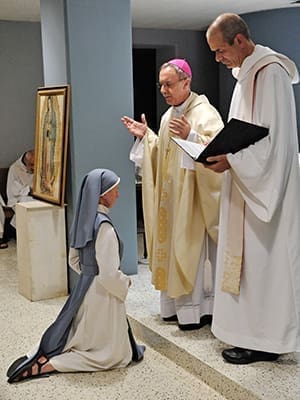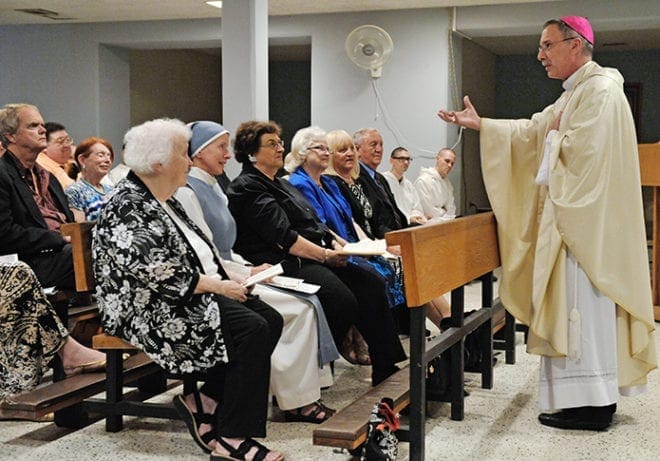Sister Mary Beatrice Raphael (formerly Bette Potter, M.D.) sits before the altar and tabernacle in her Conyers home chapel, where she spends time in prayer during various hours of the day. Photo By Michael Alexander
Conyers
Devout doctor chooses hermitage ‘to focus just on’ Jesus
By ANDREW NELSON, Staff Writer | Published October 2, 2014
CONYERS—Sister Mary Beatrice Raphael wakes before dawn and walks down a narrow hall to begin hours of prayer. She lights the beeswax candles. Opening the hand-carved wooden tabernacle with angels adorning its front to see the Eucharist, she kneels as she prays in this bedroom converted to a private chapel.
Later, she’ll spend time with books at her desk, where light floods the living room through a wall of windows.
This modest family home sits on the edge of the Monastery of the Holy Spirit property. The song of the cicadas, along with the noise of passing cars, fills the air. Water spills over rocks into a fishpond.
It is where Sister Beatrice, who has been on a journey of solitude for a few years, is living as a hermit.
“I was made for prayer and contemplation. I wanted to focus just on him,” said Sister Beatrice, her hair covered with a blue habit she designed. “It is falling in love. You want to be always in the presence of the one you love.”
‘Person of the desert’
Hermits, with their rigorous life of prayer, have a long history. Their chosen isolation is called an eremitical life, which comes from the Greek word for “person of the desert.”
While living withdrawn from the community, crowds often seek hermits out for their insights and prayer. St. John the Baptist, clothed in camel’s hair and eating locusts, can be considered a hermit. St. Anthony of Egypt lived in the desert during the fourth century and is considered the father of monasticism. Their habits can seem strange for the 21st century. St. Simon the Stylite lived on a pillar for 37 years. Yet the eremitical life continues to influence the church today. The well-known author and Trappist monk Thomas Merton lived for three years as a hermit. The Conyers monastery also has one monk living this life.
Sister Beatrice’s vocation as a hermit outside a religious community is found in church law but is rare. Atlanta archdiocesan church leaders had never worked with a woman or man to help them with this religious calling. Sister Margaret McAnoy, a member of the Immaculate Heart of Mary religious community and the vicar for religious in the archdiocese, had to rely on guidelines established by the Milwaukee Archdiocese on how to proceed. The guidelines had practical tips, from how to take care of grocery shopping to organizing a vow ceremony.
Hermits in the past were members of a religious order, but hermits can also take perpetual vows before a diocesan bishop. Sister Beatrice made her promises to live as a hermit to Bishop Luis R. Zarama, whose responsibilities include those in religious life.
“It is just a life of solitude and prayer. She limits the people she meets,” said Sister Margaret. She said their conversations over the years revealed a desire for Sister Beatrice to be close to Jesus.
“That’s really what we all want. We just want it in different ways,” she said.
Move toward a solitary life

Sister Mary Beatrice Raphael professes simple vows Aug. 15 to Bishop Luis R. Zarama as a consecrated woman to live the eremitic life. Trappist Father Augustine, right, assisted at the service. Photo By Lee Depkin
Born Bette Cavallo, she grew up in Marietta, one of four children. Her father was an enlisted man in the U.S. Air Force, rising to a senior master sergeant. Born in New Jersey, her family lived for a time in Japan and California, before settling in the Atlanta suburb. The family worshipped at St. Joseph Church, in Marietta, where their mother, Ruth, was parish secretary. Her oldest brother was ordained a priest for the archdiocese. Father Joe Cavallo died in 1990, after 20 years of ministry.
As a young girl, she recalled going off by herself and exploring nearby woods. She called herself a “tomboy.” She earned her diploma at Marietta High School in 1968. She attended Macon’s Mercer University for her bachelor’s degree in biology and graduated in 1981. In 1985, Cavallo finished her studies at the Medical College of Georgia with a medical degree and four years later earned certification from the American Board of Dermatology. It was the beginning of a successful medical career as a dermatologist in Athens, Augusta and Atlanta. She practiced as Bette Potter.
“I loved taking care of people. That was my thing. It is such a gift,” she said.
With success came a beloved horse farm and a business-owned condo she could use in Buckhead. “I was pretty materialistic,” she said. But then something Sister Beatrice describes as a “conversion experience” made her reconsider her life’s path.
In 2007, she was moved to foster a deeper relationship with Jesus and began receiving spiritual direction. A few years later, she researched life as a hermit and began talking with Sister Margaret. In 2013, she retired from medicine and began to move toward a solitary life.
She spent at one time 10 weeks with cloistered Cistercian nuns at Our Lady of the Mississippi Abbey near Dubuque, Iowa. As much as she liked the balance of work and prayer there, it also limited her time spent in Eucharistic adoration, a practice she began at the Cathedral of Christ the King and finds a “much deeper experience with God.”
This Aug. 15, she made a simple profession of vows before Bishop Zarama, Sister Margaret, family members and friends in a small chapel at the Conyers monastery. In 2017, she expects to make her solemn profession.
Her older brother, Rick Cavallo, is facilities manager at Our Lady of the Assumption Church, in Atlanta. He said she was one of the smartest in the family. Her desire to live a life focused on prayer had to be very strong to pull her away from medicine, he said.
“She loved it. She had patients who loved her,” said Cavallo. They talk weekly, and he’ll travel to Conyers to share a vegan meal with her.
‘A new creation’
Today, Sister Beatrice, 64, prays and studies spiritual readings as part of the rhythm of life. She’ll do work to keep up the house and the yard, which she rents from the monastery. In addition, she helps once a week to care for elderly monks in the monastery infirmary. Her day begins at 4 a.m. with vigils and ends at 8 p.m. after prayers to close the day.

Bishop Luis R. Zarama speaks informally with Sister Mary Beatrice Raphael before she professes her vows as a consecrated woman to live the eremitic life. Sister Beatrice is flanked by Immaculate Heart of Mary Sister Margaret McAnoy on the left and her family on the right. Sister Margaret, vicar for religious, assisted Sister Beatrice as she prepared for consecrated life. Photo By Lee Depkin
She chose to change her name because “it signals I am a new creation.” The names are significant. St. Beatrice was a 15th century sister who founded an order of contemplative sisters, and Raphael, the archangel, is the patron of physicians.
She was married, divorced and received an annulment. Her son’s family lives in Chicago. She keeps in touch with them and her grandchildren at the urging of Sister McAnoy. “Family is so central to our whole spiritual lives,” said Sister McAnoy. A recent visit by her family to her hermitage was “absolute heaven,” said Sister Beatrice.
Sister Beatrice lives on her Social Security income and other funds she received by selling her possessions. Books like a natural world study of “Dragonflies and Damselflies” together with “Spiritual Combat” are found in her library. A nearby Bible is open to the Song of Songs. On her arm, almost hidden by a sleeve, is a wrist rosary. Prayer for her isn’t just time spent in her chapel, but she considers studying and working as prayer.
Sitting at her desk in front of the picture window, the retired physician talked about how God gives different gifts to different people. She illustrated her point with the biblical story told by St. Luke of Martha and Mary. In the story, Martha is busy tending to the traditional role of hospitality and waiting on Jesus, while Mary throws over the conventions to simply listen to Jesus.
“She is me. Prayer has an immense value,” she said.
Twice a month, she’ll drive to the nearby Publix store for groceries and pick up other supplies. It’s an unusual experience, she said, adding she feels “out of place.”
She’s been living this solitary life for three years, two on her own and one year to test her vocation. In a hot and humid chapel at the monastery in August, Sister Beatrice pledged to Bishop Zarama “to live poverty, chastity and obedience for three years according to my personal Rule of Life as a hermit.”
The handwritten document with her promises stated in black ink: “With joy I seal this covenant.”
“I love people. I’m not escaping people,” said Sister Beatrice. “I would just rather be with God instead of people. I’m happier than I’ve ever been.”